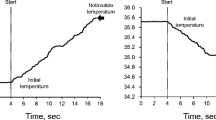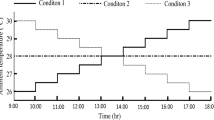Abstract
We studied eight young adult men to see whether a supine posture caused a fall in body core temperature in the cold, as it does in thermoneutral conditions. In air at 31°C (thermoneutral), a supine posture for 3 h reduced mean aural, gastric, oesophageal and rectal temperatures by 0.2–0.4°C, compared to upright and increased femoral artery blood flow from 278 (SEM 42) ml · min−1 whilst upright to 437 (SEM 42) ml·min−1 whilst supine. In cold air (8°C) the supine posture failed to reduce these temperature differences significantly, or to increase femoral blood flow; it reduced heart rate, and increased arterial systolic and pulse pressures adjusted to carotid sinus level, less than in thermoneutral conditions. However, the behaviour of core temperature at the four sites was significantly nonuniform between the two postures in the cold, mainly because the supine posture tended to reduce rectal temperature. It may have done so by reducing heat production in the muscles of the pelvis, since it reduced overall metabolic rate from 105 (SEM 8) to 87 (SEM 4) W · m−2 in the cold. In other respects the results indicated that posture ceased to have an important effect on body core temperatures during cold stress.
Similar content being viewed by others
References
Azzaroni A, Parmeggiani P (1995) Postural and sympathetic influences on brain cooling during the ultradian wake-sleep cycle. Brain Res 671:78–82
Beiser G, Zelis R, Epstein S, Mason D, Braunwald E (1970) The role of skin and muscle resistance vessels in reflexes mediated by the baroreceptor system. J Clin Invest 49:225–231
Chaudhuri K, Thomaides T, Mathias C (1992) Abnormality of superior mesenteric artery blood flow responses in human sympathetic failure. J Physiol (Lond) 457:477–489
Cranston W, Gerbrandy J, Snell E (1954) Oral, rectal and oesophageal temperatures and some factors affecting them in man. J Physiol (Lond) 126:347–358
Demolis P, Asmar R, Levy B, Safar M (1991) Non-invasive evaluation of the conduit function and the buffering function of large arteries in man. Clin Physiol 11:553–564
Donaldson G, Mridha K, Whelan L, Keatinge W (1993) Effects of posture on core temperature during cold stress in man. J Physiol (Lond) 467:79P
Ebert T, Stowe D, Barney J, Kalbfleisch J, Smith J (1982) Summated circulatory responses of thermal and baroreflexes in humans. J Appl Physiol 52:184–189
Eckberg D (1980) Non-linearities of the human carotid baroreceptors reflex. Circ Res 47:208–216
Edfelt M, Lundvall J (1993) Sympathetic baroreflex control of vascular resistance in comfortably warm man. Analysis of neurogenic constrictor responses in the resting forearm and in its separate skeletal muscle and skin tissue compartment. Acta Physiol Scand 147:437–447
Hainsworth R, Al-Shamma Y (1988) Cardiovascular responses to upright tilting in healthy subjects. Clin Sci 74:17–22
Hassan A, Tooke J (1988) Effect of changes in local skin temperature on postural vasoconstriction in man. Clin Sci 74:201–206
Hayes W, Winkler R (1971) Statistics: probability, inference and decision. Holt, Rinehart and Winston, New York, pp 735–738
Haywood M, Keatinge W (1981) Roles of subcutaneous fat and thermoregulatory reflexes in determining ability to stabilize body temperature in water. J Physiol (Lond) 320:229–251
Jacobsen T, Morgan B, Scherrer U, Vissing S, Lange R, Johnson N, Ring W, Rahko P, Hanson P, Victor R (1993) Relative contributions of cardiopulmonary and sinoaortic baroreflexes in causing sympathetic activation in the human skeletal muscle circulation during orthostatic stress. Circ Res 73:367–378
Keatinge W (1969) Survival in cold water; the physiology and treatment of immersion hypothermia and drowning. Blackwell, Oxford, pp 12–16
Keatinge W, Sloan R (1975) Deep body temperature from aural canal with servocontrolled heating to outer ear. J Appl Physiol 38:919–921
Keatinge W, Mason A, Millard C, Newstead C (1986) Effects of fluctuating skin temperature on thermoregulatory responses in man. J Physiol (Lond) 378:241–252
Koch E (1931) Die reflektorische Sehsteuerung des Kreislaufe. Steinkoff, Dresden
Livingstone S, Grayson J, Frim J, Allen C, Limmer R (1983) Effect of cold exposure on various sites of core temperature measurements. J Appl Physiol 54:1025–1031
Morgan R, Psaila J, Stone J, Carolan G, Woodstock J (1991) Effect of postural change on common femoral artery volume flow, measured by duplex ultrasound, in normal subjects and patients with peripheral vascular disease. J Biomed Eng 13:244–248
Niebauer M, Zucker I (1985) Static and dynamic responses of carotid sinus baroreceptors in dogs with chronic volume overload. J Physiol (Lond) 369:295–310
Nielsen M, Herrington L, Winslow C (1939) The effect of posture on peripheral circulation. Am J Physiol 127:573–580
Pelletier C, Clement D, Shepherd J (1972) Comparison of afferent activity of canine aortic and sinus nerves. Circ Res 31:557–568
Sleight P, Robinson J, Brooks D, Rees P (1977) Characteristics of simple carotid sinus baroreceptor fibres and whole nerve activity in the normotensive and the renal hypertensive dog. Circ Res 41:750–758
Tripathi A, Nadel E (1986) Forearm skin and muscle vasoconstriction during lower body negative pressure. J Appl Physiol 60:1535–1541
Weir J (1949) New methods for calculating metabolic rate with special reference to protein metabolism. J Physiol (Lond) 109:1–9
Wells P (1990) Blood flow: insights from ultrasound. Proc Inst Mech Eng 204:1–20
Woodhouse P, Keatinge W, Coleshaw S (1989) Factors associated with hypothermia in patients admitted to a group of inner city hospitals. Lancet 11:1201–1205
Author information
Authors and Affiliations
Rights and permissions
About this article
Cite this article
Donaldson, G.C., Scarborough, M., Mridha, K. et al. Effect of posture on body temperature of young men in cold air. Europ. J. Appl. Physiol. 73, 326–331 (1996). https://doi.org/10.1007/BF02425494
Accepted:
Issue Date:
DOI: https://doi.org/10.1007/BF02425494




